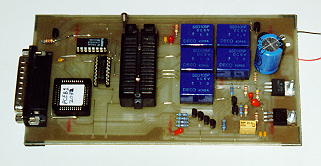

This creates an avalanche discharge of electrons, which have enough energy to pass through the insulating oxide layer and accumulate on the gate electrode. Storing data in the memory requires selecting a given address and applying a higher voltage to the transistors. In effect, the stored charge on the floating gate allows the threshold voltage of the transistor to be programmed. Presence of a voltage on this gate creates a conductive channel in the transistor, switching it on. The switching state of the field-effect transistor is controlled by the voltage on the control gate of the transistor. Each bit of the word is a 1 or 0, depending on the storage transistor being switched on or off, conducting or non-conducting.Ī cross-section of a floating-gate transistor To retrieve data from the EPROM, the address represented by the values at the address pins of the EPROM is decoded and used to connect one word (usually an 8-bit byte) of storage to the output buffer amplifiers. A control gate electrode is deposited and further oxide covers it. The floating-gate electrode has no connections to other parts of the integrated circuit and is completely insulated by the surrounding layers of oxide.

An insulating layer of oxide is grown over the channel, then a conductive (silicon or aluminum) gate electrode is deposited, and a further thick layer of oxide is deposited over the gate electrode. Source and drain contacts are made to regions at the end of the channel. Each field-effect transistor consists of a channel in the semiconductor body of the device. Įach storage location of an EPROM consists of a single field-effect transistor. Frohman designed the Intel 1702, a 2048-bit EPROM, which was announced by Intel in 1971. Building on this concept, Dov Frohman of Intel invented EPROM in 1971, and was awarded U.S. In 1967, Dawon Kahng and Simon Sze at Bell Labs proposed that the floating gate of a MOSFET could be used for the cell of a reprogrammable ROM (read-only memory). While he did not pursue it, this idea would later become the basis for EPROM technology. In 1963, he noted the movement of charge through oxide onto a gate. Stored charge on these isolated gates changes their threshold voltage.įollowing the invention of the MOSFET (metal-oxide-semiconductor field-effect transistor) by Mohamed Atalla and Dawon Kahng at Bell Labs, presented in 1960, Frank Wanlass studied MOSFET structures in the early 1960s. The small quartz window admits UV light for erasure.ĭevelopment of the EPROM memory cell started with investigation of faulty integrated circuits where the gate connections of transistors had broken. Operation Īn Intel 1702A EPROM, one of the earliest EPROM types (1971), 256 by 8 bit. EPROMs are easily recognizable by the transparent fused quartz window in the top of the package, through which the silicon chip is visible, and which permits exposure to ultraviolet light during erasing. Once programmed, an EPROM can be erased by exposing it to strong ultraviolet light source (such as from a mercury-vapor lamp).

It is an array of floating-gate transistors individually programmed by an electronic device that supplies higher voltages than those normally used in digital circuits. Computer memory that can retrieve stored data after a power supply has been turned off and back on is called non-volatile.

(Redirected from EPROM programmer) Computer memory typesĪn EPROM (rarely EROM), or erasable programmable read-only memory, is a type of programmable read-only memory (PROM) chip that retains its data when its power supply is switched off.


 0 kommentar(er)
0 kommentar(er)
